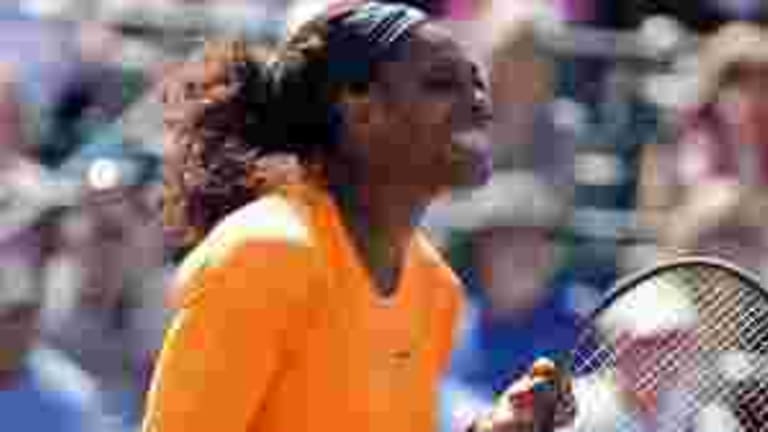CHARLESTON, S.C.—It was 2-2, 22 minutes in—the same amount of time it took Serena Williams to win the first set against her sister in Saturday’s much-hyped semifinal. About 22 minutes later, after Jelena Jankovic had won four of the next five games, it was clear that the weekend’s best throwback match wouldn’t be Serena vs. Venus, but Serena vs. Jankovic.
And that remained true, even though both Jankovic and Venus went on to win the same number of games—two—after their first set of play with Serena. From that point on in today’s contest, Williams’ focus and shotmaking improved, while Jankovic’s level dropped, though not as much as the lopsided scores would indicate. But against an in-form Serena, any fall becomes precipitous.
The final score of this final was 3-6, 6-0, 6-2, giving Serena her second consecutive Family Circle Cup and her second straight tournament win, following her triumph in Miami. Williams’ decision to skip Indian Wells prevents her from capturing the celebrated, cross-country, hard-court double in March, but back-to-back wins in Miami and Charleston are nearly as impressive, what with the change in surfaces and a very strong field in South Carolina.
Jankovic, one of the many former Charleston champs in this year’s draw, brought forth the type of tennis that once took her to the winners’ circle in the first set. Her slides and swings fused into a picture-perfect way to play on the green Har-Tru underneath a flawless blue sky. Combined with her pink dress, it was a sight to see in a city awash in botanical beauty, colorful pants, and eye-catching architecture.
But the most important shot to Jankovic was perhaps the plainest of them all, the serve. It was essential against Serena, who can take control and command of any rally, with any stroke, at any time, seemingly at will. It was put to the test right away, as Serena earned the match’s first two break points while leading 2-1, and she earned three more in the same game. But Jankovic served and hit her way out of early trouble, the final time with a wide serve that negated a poor error a point earlier. It was a long and arduous hold for 2-2, but the kind of play it demanded persisted through the rest of the first set.
It wasn’t altogether surprising for Williams to fall behind 0-40 in the following game, even for someone as battle-tested as the world No. 1. Jankovic’s jolt of confidence and inspired play saw her take advantage of any Serena error, and when the American hit a drop shot that sat up too high, the Serb artfully put away the ball at net to grab a break-of-serve lead. Four games later, despite a noticeable Williams push—her grunts, like umpire Kader Nouni’s intoning, were heard in the highest reaches of the stadium—the set went to Jankovic. She had withstood the surge, and suddenly it appeared that Serbia might dethrone the United States in both the northwest and southeast corners of the country.
One constant remained in Williams’ favor, however: Jankovic would surely need to play as well as she did in the first set for the rest of the match if she was to win. Serena, on the contrary, is always capable of winning without her best. That second constant was never put to the test, however, as Williams played some of her best tennis in the second and third sets, losing just two games while winning countless points with her backhand. It is a devastating shot on any court, but on clay Serena has time to give it both the power and direction needed to overwhelm most any foe, including the nimble Jankovic. Throughout today’s match, and yesterday’s against Venus, I found myself wondering why Serena hasn’t enjoyed more success at Roland Garros.
Of course, it wouldn’t be a Serena vs. Jelena match without at least some drama. We got it early in the second set, with Jankovic ready to serve and Serena not ready to receive. Jankovic hit the ball anyways, and Nouni made her serve again, saying that Serena wasn’t ready. Jankovic objected, at one point mimicking Serena’s return stance to show that she appeared ready to play. Serena didn’t see it that way. According to Ben Rothenberg of the New York Times, Jankovic said to Serena, “How long to I have to wait?” Serena replied, “Until I’m ready.”
Williams had the last word in that exchange, and soon enough the match itself. If Serena’s eventual break of serve in that opening game signaled a shift in momentum, her break for 3-0 validated that prevailing thought, and her third break for 5-0 proved that the mental match had completely swung in her favor.
With her mind and body doing exactly what they were supposed to, Serena never looked back, and a match that had the makings of a classic was over in under two hours.
